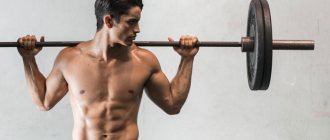Faster. Higher. Stronger. We all know that for professional athletes, life is scheduled as a series of training sessions, and other areas of life barely fit into the busy schedule. Achievements at the Olympics and championships seem to us something transcendental and unreal, and champions seem like superhumans. Competitions are very interesting to watch on TV or in the stadium, but it is completely incomprehensible how we, people who do not strive for medals, can have anything in common with these incredibly strong and resilient athletes.
If we don’t need to run a distance 1.5 seconds faster than a friend, jump further than a colleague and dive better than a neighbor; if we just want to be in good shape, be fit and easily climb to the 7th floor on foot, can we borrow some techniques from sports? We definitely can! After all, we and athletes use the same mechanisms and properties of the body.
Adaptation is the leading force in developing the body's capabilities. We have already touched on the importance and significance of adaptation processes in increasing the effectiveness of training in the article “Changing the load to increase the effectiveness of the training process.”
One of the well-known tools that uses the body’s adaptive capabilities is the periodization of the training process.
| Periodization is long-term planning of physical activity, in which training is built according to a specific system, consisting of specific phases of varying duration, purpose and regularity. |
At the same time, to achieve the desired results, variables (sets, repetitions, load, number of exercises, rest periods, etc.) are planned in such a way as to trigger specific adaptation mechanisms. Phases can last from several days to several years.
There are three main types of periodization of the training process and each has its own pros and cons. Below we will look at each of them in detail.
Planning the training process
Periodization of loads is the main condition for the effectiveness of sports activities in the long term.
To keep your muscles “toned” and maintain optimal physical shape, you can use the following techniques:
- alternating different types of training (strength, cardio, gymnastics);
- a combination of different exercises - basic, isolating, for the whole body or individual muscle groups;
- varying the number of repetitions, approaches, working weight, tempo;
- changing the frequency of classes.
Periodization of the training process allows you to avoid overtraining, fatigue and negative consequences for the athlete’s health.
Understanding fractality
Taking into account the complexity and chaos of the game, it is not necessary to recreate 11 vs 11 situations in the training process. Sometimes it is necessary to simplify some elements to make it easier for football players to cope with game situations. Any simplification leads to the loss of important components, so it is important not to lose touch with reality.
If simplification is acceptable, we can use the theory of fractals. Reducible variables in this case can be the number of players, the size of the playing area, time for an exercise, rest time between exercises, and the completion of episodes. It is important to maintain chaos, complexity, key goal, decision making, intensity and consistency with the style of play.
Victor Freud gave an excellent definition of fractality: “If you pour water from a bottle into a cup, the water in the cup will be similar to the water in the bottle, but the volume will be reduced.”
An example of an entire team and its fractal in a game episode
The meaning of periodization
In strength sports, adaptability is used to continually improve performance and prepare for competition. But there is no single correct way to periodize the training process.
Periodization refers to long-term planning for the development of certain characteristics; it has a specific goal and time reference.
Periodization of training creates a cycle during which processes occur aimed at a specific result. The periodization of training can be linear, wave-like, or block.
PERIODIZATION IN AMATEUR TRAINING
For a person whose main goal is to achieve and maintain optimal physical fitness, periodization should be understood as changing the parameters of training sessions at certain intervals. When planning your training process, you can use the following scheme.
1. Define your goal. Reducing fat mass, developing strength or endurance, relief, increasing flexibility and so on.
2. Outline ways to achieve the goal. What type of training will you need, how long will the planned training cycle take, what opportunities do you have.
3. Connect the moment of pleasure from the activity. Consider possible activities not only for their effectiveness, but also based on your preferences. For example, from a set of cardio exercises, you may prefer running or Nordic walking, cycling or jumping rope, aerobics or energetic dancing. You can develop flexibility with various types of yoga, stretching or dancing, etc.
4. Identify the phases - microcycles, mesocycles, macrocycles. You can rely on the time frames offered by various approaches to sports periodization, or outline your own based on your feelings and current circumstances.
5. Plan the intensity and volume of loads within the phases. Proceed from a gradual increase in loads. Be sure to include periods of active rest or recovery in your program. After such periods, begin the next phase with less intense loads than before the break.
| Remember - alternating periods of rest and work is the key to maximizing the use of adaptation mechanisms, and therefore to greater results. |
6. Review the program regularly. Assess your developing characteristics, your well-being, mood and current life circumstances.
As with building a nutritional system, the training process requires a certain amount of individual experimentation in order to determine what works for you.
Plan your training cycles, be sure to include an element of challenge, but watch yourself and be prepared to flexibly change the load, and then the body will respond to you with gratitude and good shape.
Author: Anna Nesterova, strength sports coach, curator of the Ideal Body School #sekta
References: 1. Daniel Lorenz, Scot Morrison, Current concepts in periodization and conditioning for the sports physical therapist.
2. V.B. Issurin, Block periodization in sports training 3. Kelley Strohacker, Daniel Fazzino, Whitney L. Breslin, Xiaomeng Xu, The use of periodization in exercise prescriptions for inactive adults: A systematic review 4. Keith Painter, Guy Haff, Michael Ramsey, Jeff McBride, Travise Triplett, William Sands, Hugh Lamont, Margaret Stone, Michael Stone, Strength Gains: Block Versus Daily Undulating Periodization Weight Training Among Track and Field Athletes 5. C.de Lima, DA Boullosa, AB Frollini, FF Donatto, RD Leite, PRGGonelli , MIL Montebello, J. Prestes, MC Cesar, Linear and Daily Undulating Resistance Training Periodizations Have Differential Beneficial Effects in Young Sedentary Women. 6. Denis Foschini, Ronaldo C. Araújo, Reury F. P. Bacurau, Aline De Piano, Sandro S. De Almeida, June Carnier, Thiago D. S. Rosa, Marco T. De Mello, Sérgio Tufik and Ana R. Dâmaso, Treatment of Obese Adolescents: The Influence of Periodization Models and ACE Genotype. 7. Bartolomei S, Hoffman JR, Merni F, Stout JR. A comparison of traditional and block periodized strength training programs in trained athletes. 8. Brad H. DeWeese, Guy Hornsby, Meg Stone, Michael H. Stone. The training process: Planning for strength–power training in track and field. Part 1: Theoretical aspects.
Features of training with linear periodization
This type of periodization is considered classic; it is based on changing the number of repetitions and load during planned periods.
- Focus and predictability.
Each phase has one focus, so it is clear what needs to be worked on in training. The schedule is planned in such a way that you reach the peak of your capabilities at a certain time - for example, before the start of a competition. That is, the training program has a beginning and an end.
- Gradualism.
All sports characteristics (speed, strength, power) increase gradually: finishing the phase, the athlete moves to a new level, to other training.
- Clarity.
Simple load changing schemes are available even for amateurs. “Complication” occurs mainly due to an increase in the weight of the burden. Each workout creates a slight “overload” that encourages you to push yourself to your limits and then push them further.
Comments on the program
- The designations A1 and A2 (B1 and B2) mean that this pair of exercises is performed as a superset. Those. you perform one set in exercise A1, rest, and perform one set in exercise A2.
- Exercise designations A and B mean that the exercises are performed in the usual order. First, all approaches in exercise A, then all approaches in exercise B.
- Depending on the training volume (number of sets and repetitions), change the intensity of the exercises (weights). More volume - less weight. And vice versa.
- Don't exercise to failure. Never.
- Before moving on to the second part of the series, complete the first part.
- Before starting the third part of the cycle, take a week off from the gym. Just don't come into it at all.
- The entire training cycle takes from 14 to 20 weeks.
Read before training:
All basic exercises with correct technique
Training program for maximum effective muscle growth from scientists
How hard should you train?
5 reasons why you look like you don't exercise
5 reasons why your workout is ineffective
Squats in Bodybuilding and Powerlifting: 10 Important Differences
How to pump up the press correctly
How to squat with a barbell correctly
Training for a beginner. The beginning of time.
12 rules. How to avoid looking like a sucker at the gym
What is “overtraining” and why is it very dangerous?
How to plan training with wave periodization
With the wave approach (as opposed to linear periodization), the volume and loads change frequently, but according to the principle of “one step back, and then two forward.” Light exercises are replaced by intensive ones, and vice versa.
- Workouts without stress.
The program includes rest periods that help the body regain its strength, this reduces the risk of overtraining.
- Stable preservation of results.
During each phase, with the selected focus, other physiological parameters do not decline, but are trained in a supporting mode. As a result, strength, endurance, and power are simultaneously “pumped up” during the program, but this may occur unevenly.
- Increased adaptive abilities.
The body reacts flexibly to changes in physical activity in sports and everyday life and easily adapts.
Understanding the difficulty of the game
Tactical periodization challenges the outdated way of thinking about football, where different aspects of the game (physical, technical, tactical, psychological) are trained separately. The traditional approach does not follow a logical order of play and does not provide an optimal method for teaching and training players.
Naturally, the game of football is chaotic. Two teams of eleven players, playing with one ball, try to protect their goal and hit the opponent’s goal, the referee monitors compliance with the rules of the game. Each team has a strategy to influence the outcome. A set of predefined behaviors are established based on different situations on the field. There are attempts to catch the opponent in unpredictability. All of the above complicates the game by several levels, and the ability to observe individual components disappears. For this reason, Aristotle's expression, "The whole is greater than the sum of its parts," can easily apply to football.
Effects of block periodization
Block periodization of training involves the sequential passage of three phases:
- accumulation (to build a training base from basic exercises),
- transformation (performing specific exercises at a level of 75-90% of your own maximum),
- implementation of established parameters for performing more complex techniques almost to the limit of one’s capabilities - from 90% and above.
The main parameters are developed regularly, taking into account the period of delayed effect and the persistence of changes. Therefore, with block periodization, strength and endurance indicators are maintained year-round.
Linear cycling in bodybuilding
In bodybuilding, the development of strength indicators (strength) is of very auxiliary importance, because there the shape (volume) and definition (muscle definition) are more important. It is on this basis that a linear macrocycle is built.
Therefore, such a macrocycle for an athlete can EITHER or NOT include a strength training phase (lasting, as a rule, no more than 2-4-6 weeks). But the phase of gaining muscle mass and DRYING (achieving relief) are mandatory (in bodybuilding).
Bodybuilders typically compete (during the year) twice. The first time IN SPRING, the second time in AUTUMN. Therefore, the duration of a linear MICROCYCLE CAN BE 18-24 weeks. If according to the plan a bodybuilder has only ONE PERFORMANCE (competition) during the YEAR, then the duration of the MACRO CYCLE, of course, INCREASES to 30-32 weeks.
Therefore, you can plan a MACRO CYCLE like this:
- Strength training (development) 2-4 weeks.
- Hypertrophy phases (MASS WORK; muscle growth) 8-12 weeks.
- Drying (work on relief) 8-10 weeks.
Each of the three phases are mesocycles, the training weeks within which are called microcycles. This six-month period of training periodization will be called a macrocycle. However, linear periodization of training has DISADVANTAGES , which consist in the fact that the athlete loses endurance during strength training, and strength is lost during mass training. WOW SO WOW









